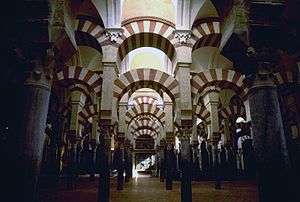Andalusia: Difference between revisions
| Line 161: | Line 161: | ||
*[http://www.crwflags.com/fotw/flags/es-an_hi.html History of the Andalusian Flag] |
*[http://www.crwflags.com/fotw/flags/es-an_hi.html History of the Andalusian Flag] |
||
*[http://www.paradoxplace.com/Photo%20Pages/Spain/Andalucia/Andalucia.htm Andalucia Photo and History Pages] |
*[http://www.paradoxplace.com/Photo%20Pages/Spain/Andalucia/Andalucia.htm Andalucia Photo and History Pages] |
||
*[http://www.fiestasdeandalucia.com]Fairs and traditional fiestas of Andalusia |
*[http://www.fiestasdeandalucia.com/ FiestasdeAndalucia.com]Fairs and traditional fiestas of Andalusia |
||
Revision as of 15:34, 20 July 2007


Andalusia (Spanish: Andalucía) is an autonomous community of Spain. Andalusia is the most populous and the second largest, in terms of its land area, of the seventeen autonomous communities of the Kingdom of Spain. Its capital is Seville.
Andalusia is bounded on the north by the autonomous communities of Extremadura and Castilla-La Mancha; on the east by the autonomous community of Murcia and the Mediterranean Sea; on the west by Portugal and the Atlantic Ocean; on the south by the Mediterranean Sea, the Strait of Gibraltar, which separates Spain from Morocco, and the Atlantic Ocean. The British colony of Gibraltar shares a three-quarter-mile land border with the Andalusian province of Cádiz at the eastern end of the Strait of Gibraltar.
History
Tartessians and Phoenicians
Tartessos, the capital of the once-powerful Tartessian civilization, was located in Andalusia in pre-Roman times. The Phoenicians colonized several areas on the Andalusian coast during the early part of the first millennium BCE. The Oldest being Cadiz around 1100BC. This brought them in contact with the innerland Tartessians.
Carthaginians and Romans
With the fall of Pheonicia in the East, the Semitic towns on the coasts of Andalusia turned into the biggest North African Pheonician colony Carthage and Andalusia became the major staging ground for the war vs Rome led by Hannibal from Cartagena. The Romans eventually were able to reverse the tide of the war and conquer Andalusia. From then on the region was given the name Betica.
Vandals and Visigoths
The Vandals moved briefly through the region during the 5th century CE before settling in North Africa, after which the region fell into the hands of the Kingdom of the Visigoths who had to face the Byzantine interests in the region.
Arabs and Moors
The Umayyad Caliphate invasion of the Iberian peninsula in 711-718 marked the collapse of Visigothic rule. Andalucian culture was deeply influenced by half a millennium of Muslim rule during the Middle Ages. Córdoba became the largest and richest city in Western Europe and one of the largest in the world. The Moors established universities in Andalucia, and cultivated scholarship, bringing together the greatest achievements of all of the civilisations they had encountered. During that period Moorish and Jewish scholars played a major part in reviving and contributing to Western astronomy, medicine, philosophy and mathematics. With the fall of Seville in 1248 most of Andalucia came under Castilian control, leaving only the emirate of Granada under Muslim rule until it too was conquered by the Catholic monarchs, Ferdinand and Isabella in 1492. The largest Arabic speaking population was in Andalucia, which also received Moors from other regions who were driven south by the Reconquista, and although many either converted or left later, they gave the region its distinctive character till this day.
Andalucia is known for its Moorish and Moorish influenced architecture. Notable examples include the Alhambra in Granada, the Mezquita in Córdoba, the Torre del Oro and Giralda towers and the Reales Alcázares in Seville, and the Alcazaba in Málaga. Archaeological ruins include Medina Azahara, near Córdoba, and Itálica, near Seville, and at Huelva, the Andalusian port from which Columbus's expedition of discovery was launched.
The Spanish language spoken in the Americas is largely descended from the Andalusian dialect of Spanish. This is due to the role played by Seville as the gateway to Spain's American territories during the sixteenth and seventeenth centuries.
Andalusia Day (in Spanish, Día de Andalucía) is celebrated on February 28, to commemorate the date of the successful referendum vote on autonomy.
Geography
Administrative divisions

| Province | Capital | Population | Density | Municipalities |
|---|---|---|---|---|
| Almería | Almería | 635.850 | 72,47 hab./km² | Municipalities |
| Cádiz | Cádiz | 1.180.817 | 158,80 hab./km² | Municipalities |
| Córdoba | Córdoba | 788.287 | 72,47 hab./km² | Municipalities |
| Granada | Granada | 882.184 | 68,70 hab./km² | Municipalities |
| Huelva | Huelva | 483.792 | 47,67 hab./km² | Municipalities |
| Jaén | Jaén | 662.751 | 49,09 hab./km² | Municipalities |
| Málaga | Málaga | 1.491.287 | 204,06 hab./km² | Municipalities |
| Seville | Seville | 1.813.908 | 129,23 hab./km² | Municipalities |

Other important Andalusian cities are:
- El Ejido, and Roquetas de Mar, Almería
- La Línea de la Concepción, Algeciras, Sanlúcar de Barrameda, Rota, San Fernando, Jerez, and El Puerto, Cádiz
- Almuñécar, Guadix and Motril, Granada
- Úbeda and Baeza, Jaén
- Antequera, Ronda and Marbella, Málaga
- Dos Hermanas, Lebrija, Osuna and Utrera, Sevilla
Economy
Transports and commerce
The main road in the region is the European Route E15
Government and Politics
Monuments
Native or Famous people from Andalusia
- Antonio Banderas
- Carmen Sevilla
- Manuel de Falla
- Lola Flores
- Felipe Gonzalez
- Blas Infante
- Maimonides
- Federico Garcia Lorca
- Pablo Picasso
- Rocio Jurado
- Isabel Pantoja
- Estrella Morente
- Diana Navarro
- Diego Velázquez
- Gustavo Adolfo Becquer
- Trajan
- Seneca the Younger
Others topics
See also
- Andalusian people
- List of Andalusians
- Andalusian nationalism
- Music of Andalusia
- Andalusian cuisine
- Canal Sur
- Canal Sur Radio
- Canal Fiesta Radio
References
External links
- Official Tourism Website of Andalusia
- History of the Andalusian Flag
- Andalucia Photo and History Pages
- FiestasdeAndalucia.comFairs and traditional fiestas of Andalusia
